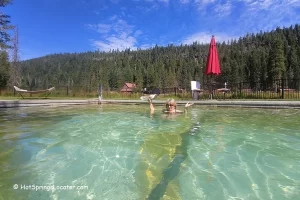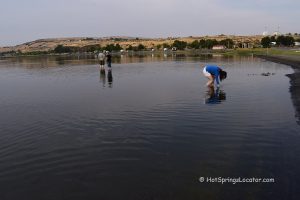• Benefits of natural hot springs' thermal mineral-rich water have been medically proven
• However, there are certain risks and side effects to be aware of
The furthest thing in the mind of a hot springs visitor is those hot springs’ risks and side effects.
The benefits of natural hot springs' mineral-rich water have been medically proven. Hot water helps balance and rejuvenate our body and mind. It helps alleviate joint and muscle problems, lower blood pressure, boost metabolism, relieve stress, cure insomnia, and reduce depression and anxiety. In addition, minerals such as sulfur, silica, and others are linked to curing some skin conditions, including psoriasis, acne, and eczema.
However, few truly beneficial things on this planet come free of risks and possible side effects, and hot springs are no exception.
We list some of the major ones below.
High Temperatures
It is a known fact that hot springs can range from mildly warm to extremely hot. A burn may occur at 110°F (43°C) if you stay in the hot water for a long time. At 118°F (48°C), human skin can sustain first-degree burns. Exposure to a temperature above 130°F (54°C) can be enough to cause second or even third-degree burns. At temperatures above 158°F (70°C), full-thickness tissue (epidermis and dermis) is destroyed almost instantaneously.
The optimal temperature of a hot bath for healthy adults ranges from 99°F (37°C) to 105°F (41°C). However, if the water is too hot for you or you have health issues, decrease the duration of your bathing. Prolonged soaking may lead to hyperthermia (high body temperature) and put you at significant risk for heatstroke, which can occur when the body temperature goes above 104°F (40°C). Heatstroke can cause damage to your brain and other organs.
Before entering wild hot springs, use a thermometer to measure the water temperature. Due to specific geological features in some hot springs, their temperature can go from warm to scalding in seconds. Be careful if the springs are undeveloped and unknown to you. Use common sense and exercise your best judgment to make the right decision.
Sulfur
Sulfur occurs naturally on Earth and escapes in the form of gas with the smell of "rotten eggs." Additionally, sulfur exits in the form of sulfates in the hot springs water and hydrogen sulfide that evaporates, giving off the distinctive sulfur odor.
Although sulfur water provides many therapeutic and healing benefits, it can trigger an allergic reaction in some people. Talk with your healthcare provider about the risks. Do not postpone visiting your doctor if you have signs of sulfur allergy.
Hydrogen sulfide is a toxic gas that can be fatal in high concentrations. It may lead to the blocking of cellular respiratory enzymes, thus causing cell anoxia and cell damage. Do not bathe in unknown wild hot springs, particularly if they have a strong smell of "rotten eggs.”
Hot Spring Microorganisms
Hot Springs Red Spider Mites
Barely perceptible to the naked eye, those spiders are a real risk. They usually hang around hot springs, as well as on their surface. These spiders look for new places to lay their eggs and often end up on clothes, towels, and other personal belongings. As long as they are next to your skin, you will likely get bitten.
Fortunately, a healthy adult's immune system should be able to neutralize the mild toxins that spiders inject. However, the painful itching may last for weeks and worsen with scratching. The best approach here is to leave your belongings far away from the ground and apply anti-itch cream as soon as you leave the water.
Red Spider Mites in Hot Springs: Risks and Safety Tips
Hot Springs Bacteria
Another hot spring risk you should be aware of is disease-causing bacteria. Untreated hot springs contain microorganisms that can cause infection, skin rash, and gastrointestinal illness.
Thermotolerant enteric bacteria such as Escherichia coli or Enterococci can survive at temperatures ranging from 113 to 140°F (45-60°C). Legionella pneumophila, a cause of Legionnaires' disease, grows in water at temperatures between 77°F and 113°F (25-45°C).
Avoid hot springs if you have deep cuts and wounds, as they can get infected.
Hot Springs Amoebae
The microscopic organism Amoeba Naegleria fowleri can survive in temperatures as high as the human body can withstand - up to 113°F (45°C). This type of amoeba enters the human body through the nasal cavity during swimming or diving. Though rare, it has the potential to attack brain tissue. That is how it earned the name of a Brain-Eating Amoeba. The result is Primary Amebic Meningoencephalitis (PAM), aka Naegleriasis, which is a potentially lethal brain infection. People do not tend to get infected by drinking contaminated water, though.
Naegleria is found in hot springs, warm lakes and rivers, poorly maintained swimming pools and spas, soil, mud, indoor dust, aquariums, and tap water. It can also survive in saltwater. While this amoeba is commonly found worldwide, cases of infection are rare. Limited studies suggest that some people do not develop PAM, while others do. About 80% of the U.S. PAM cases are in males, and over 60% are in children aged 13 or younger.
Zero to eight Naegleriasis cases are detected annually and are associated with water exposure, typically from July to September.
According to the Centers for Disease Control and Prevention (CDC), 34 PAM cases were reported between 2010 and 2019. Thirty patients had recreational water exposure, and three were infected through nasal irrigation using contaminated tap water.
About 80% of PAM cases are in males, and over 60% are children age 13 or younger.
Primary Amebic Meningoencephalitis Prevention
- Do not lower your head into hot spring water
- Don't swim in or jump into warm freshwater lakes or rivers
- Hold your nose shut or use nose clips when jumping or diving into warm bodies or swimming pools
- Avoid disturbing the sediment while swimming in warm shallow freshwater
- Do not use untreated tap water in a neti pot to flush your sinuses or nose.
Cardiovascular Health
One of the most lauded benefits of hot springs and spa treatment is the prevention of various cardiovascular diseases. But wait—paradox incoming! It is also proven that cardiac arrests happen more often in hot springs and hot baths—likely even more often than actually reported.
Indeed, high temperatures can lower blood pressure. A sudden temperature increase, however, causes a drastic drop in blood pressure that shocks the body and stresses the heart, causing dizziness, fainting, and even cardiac arrest.
Gradual temperature change, though, has the opposite effect that improves cardiovascular function.
So, what precautions could you take? It may be as simple as giving your body ample time to adjust to the temperature. Start by dipping your legs first before gradually submerging the rest of your body in the hot springs. Take breaks after each 10-15 minutes of soaking to let your body return to its normal temperature.
Do not rush. Take your time. The whole point of hot springs is quiet relaxation in an environment where you do not have to be constantly on the run. Savor it.
People with heart conditions should seek medical advice before entering hot tubs or hot springs.
Pregnancy and Hot Springs
Soaking in hot water during pregnancy is unsafe. Hot water can raise the body temperature to 102°F (38.9°C) within 10 minutes, potentially causing hyperthermia. Some studies reported that hyperthermia during the first four to six weeks of pregnancy may increase the risk of neural tube defects (damage to the baby's brain and spinal cord). Miscarriage is another potential risk.
Additionally, some studies suggest an elevated risk of other birth defects, including heart defects, abdominal wall defects, and oral clefts.
Disclaimer
This content provides general educational information only. It has NO intention, direct or indirect, to serve as a substitute for professional medical advice, diagnosis, or treatment. We do NOT make and have NO intention to make any medical claims. Always consult your healthcare provider for more information.
You May Also Like









On your “hotsprings risks and safety” page, at the top is a picture of a hotspring resort. What is the hotspring name and where is it located?
This is Ainsworth Hot Springs Resort in British Columbia, Canada
Do you have an opinion on the safety of Crystal Cran Hot Springs in south east Orgon?
Crystal Crane is a resort. They constantly monitor water quality. I believe it is safe, and it is very relaxing.
I have visited this place three times and love it.
If on I-70 East bound in Western Colorado, the World Famous, Glenwood Springs Hot Springs ! It is amazing.. look it up…Nice Western town, Doc Holiday lived there in his day… Enjoy 🤩
If the water in the hot spring is red, is it too hot for swimming?